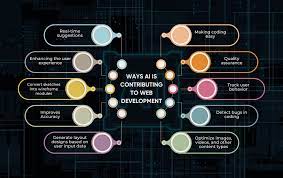The Future of Web Design: From Templates to Intelligence

Web design has always been a reflection of the technological capabilities of its time. From the earliest days of hand-coded HTML pages to the rise of content management systems and template-based platforms, the journey has been one of simplification, accessibility, and creative empowerment. But now, web design stands at the edge of a new frontier—intelligent design powered by artificial intelligence.
This shift isn't just about making web development easier; it's about fundamentally changing how we approach the concept of creating a website. We are moving away from static templates and rigid frameworks to dynamic, context-aware systems that adapt and learn. In this article, we’ll explore how web design has evolved, what’s driving this latest transformation, and what the future holds.
A Brief Look Back: The Era of Code and Templates
In the 1990s and early 2000s, building a website was a technical task. Developers wrote every line of code manually, often using simple text editors. Websites were static and required significant technical know-how to update or modify. Every change, no matter how small, demanded a touchpoint with a developer.
The introduction of platforms like WordPress, Joomla, and Drupal marked a turning point. These content management systems (CMS) made it easier for non-developers to create and manage content. Still, users needed to understand hosting, themes, plugins, and sometimes even a bit of code.
Then came the age of drag-and-drop builders—tools like Wix, Squarespace, and Webflow—which democratized web design further. These platforms offered pre-made templates, intuitive interfaces, and visual editors, allowing users to create decent-looking websites without touching a single line of code.
Templates made web design more accessible but also more homogenous. While users could customize colors, fonts, and layouts, most websites began to look and feel the same. Innovation took a backseat to convenience.
The Current Landscape: Customization vs. Simplicity
Today, users expect more than just beautiful websites. They want speed, functionality, personalization, and SEO optimization—all without the complexity of traditional development. This has created a tension between customization and simplicity.
Professional designers and developers can still create bespoke digital experiences, but that comes at a cost—both in time and money. On the other hand, small businesses, freelancers, and entrepreneurs often settle for cookie-cutter websites due to resource limitations.
This is where intelligence enters the picture. The next logical step in this evolution is moving beyond pre-made templates to systems that design themselves based on user input, goals, and even behavior. The goal isn't just to simplify web design—but to make it smarter.
The Shift to Intelligent Design
Intelligent web design leverages artificial intelligence, machine learning, and data analytics to automate and optimize the creation process. Instead of picking a theme from a list, users are asked a few questions—about their industry, style preferences, business goals, and content—and the system builds a tailored website in minutes.
What separates this from older methods is adaptability. These tools learn from user interactions, suggest improvements over time, and even generate content based on current trends or best practices. The system isn’t just reactive—it’s proactive.
For example, rather than manually optimizing a page for mobile, an intelligent system can detect device types and adjust the layout accordingly. Instead of hiring a copywriter, users can receive AI-generated content drafts tailored to their industry and target audience.
This is the realm of the AI website builder—a term that captures the essence of this transformation. It's not just about assembling pieces anymore. It's about crafting a unique, optimized, and responsive online presence through intelligent automation.
Benefits of Intelligent Web Design
1. Speed and Efficiency
AI-driven platforms can generate entire websites in a fraction of the time it would take a human team. For businesses, this means faster time to market and the ability to adapt quickly to changes.
2. Cost-Effective Solutions
Hiring designers, developers, and SEO consultants can be expensive. Intelligent platforms offer a more affordable alternative, especially for startups and small businesses with limited budgets.
3. Personalization at Scale
AI systems can analyze user data to deliver personalized experiences—from layout recommendations to content suggestions—improving user engagement and conversion rates.
4. Data-Driven Optimization
Many AI-powered platforms continuously analyze website performance and suggest or implement changes to improve speed, SEO, or user experience.
5. Accessibility and Inclusivity
With AI tools handling complex coding and design logic, more people—including those with little or no technical background—can participate in the digital economy.
Challenges and Considerations
As with any technological shift, intelligent web design comes with challenges. Privacy concerns, for one, are paramount. As platforms collect and analyze user behavior, they must be transparent and ethical in how data is used.
There’s also the issue of over-reliance. While automation can handle many aspects of web design, human creativity and strategy remain essential. A fully automated system might struggle to capture nuanced branding or emotional storytelling without human guidance.
And then there’s the concern of uniformity creeping back in. If too many people rely on the same AI platform, the web could once again become saturated with lookalike sites—albeit smarter ones.
The Road Ahead: Collaboration Between Human and Machine
The future of web design isn't one where machines replace humans but one where they collaborate. Designers will focus more on strategy, branding, and user experience, while intelligent systems handle the execution, optimization, and maintenance.
Imagine a designer sketching out a rough idea and an AI transforming it into a fully functional prototype within minutes. Or a marketer inputting campaign goals and having a website automatically adjust its messaging, layout, and calls to action based on those objectives.
This kind of synergy has the potential to elevate the entire web design process—making it faster, smarter, and more inclusive.
Conclusion
The web is evolving, and so is the way we build for it. The transition from templates to intelligence marks a significant shift—not just in technology, but in mindset. It's no longer about choosing from what exists; it's about co-creating something new with the help of powerful, intelligent tools.
As businesses and creators look toward the future, embracing intelligent design systems will be less of a luxury and more of a necessity. The promise is clear: faster creation, smarter decisions, and more meaningful digital experiences. And while the tools may change, the goal remains the same—to connect with audiences in the most effective way possible.
Note: IndiBlogHub features both user-submitted and editorial content. We do not verify third-party contributions. Read our Disclaimer and Privacy Policyfor details.







